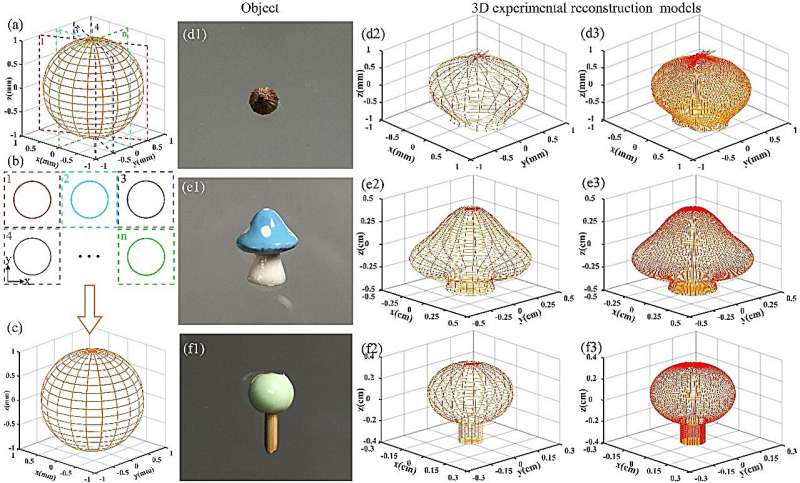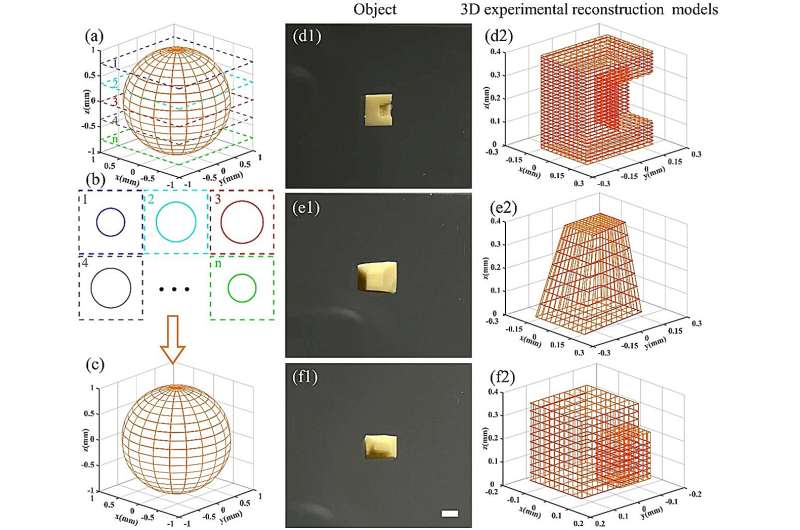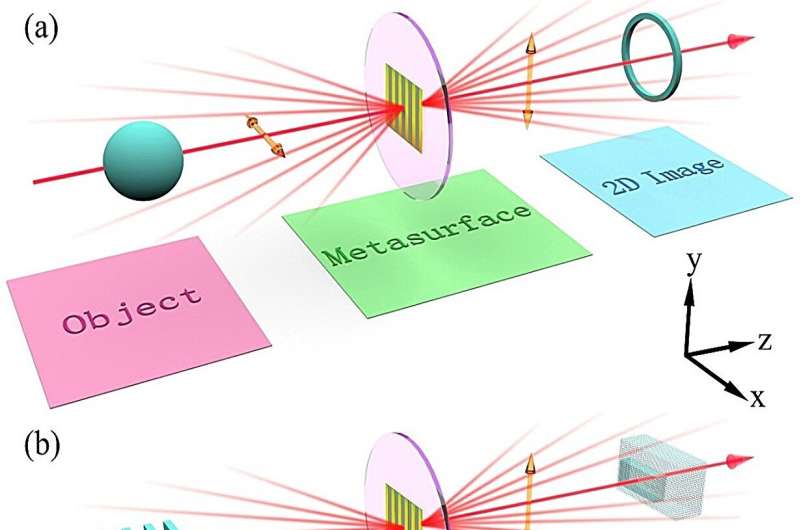Figure 1. Object recognition and all-optical 3D reconstruction system scheme diagram. (a) The system can obtain the contour surface image of the object in one processing step. (b) This all-optical computational metasurface system can reconstruct high-contrast objects and low-contrast objects. Credit: Optoelectronic progress (2023). DOI: 10.29026/oea.2023.230120
As object recognition and three-dimensional (3D) reconstruction technologies become critical in various reverse engineering, artificial intelligence, medical diagnostics, and industrial production fields, there is an increasing focus on finding efficient, faster, and more integrated methods to streamline processing .
In the current field of object recognition and 3D reconstruction, the extraction of sample contour information is mainly completed through various computer algorithms. Traditional computer processors suffer from multiple limitations such as high power consumption, low computing speed, and complex algorithms. In this regard, there has recently been increasing interest in finding alternative optical methods to perform these techniques.
The development of optical computing theory and image processing provides a more complete theoretical basis for object recognition and 3D reconstruction technology. In recent years, optical methods have received more attention as an alternative paradigm than traditional mechanisms due to their huge advantages of ultra-fast computing speed, high integration, and low latency.
As two-dimensional nanostructures at the subwavelength scale, metasurfaces have demonstrated extraordinary capabilities in the revolutionary development of optics, effectively simplifying and deeply integrating the footprint of optical systems.
In practical applications, metasurfaces have shown the ability to effectively manipulate multiple light parameters. Therefore, metasurfaces are used in many potential fields, such as optical analog computing, optical cryptography, optical component design, signal manipulation, microscopic imaging, optical imaging, and nanopainting.
As a two-dimensional artificially designed element, optical computing metasurfaces exhibit extraordinary characteristics in controlling the phase, amplitude, polarization and frequency distribution of light beams, and can perform mathematical operations on the input light field.
Recently, the research group of Professor Luo Hailu from the School of Physics and Electronics of Hunan University proposed an all-optical object recognition and 3D reconstruction technology based on optical computing metasurfaces. Unlike traditional mechanisms, this scheme reduces memory consumption in the contour surface extraction process. The identification and reconstruction of experimental results for high- and low-contrast objects are in good agreement with real objects. The exploration of all-optical object recognition and 3D reconstruction technology provides potential applications for high efficiency, low consumption and compact systems.
Author of the article, published in Optoelectronic progress, proposed an all-optical object recognition and 3D reconstruction technology based on optical computing metasurfaces. By designing and manufacturing optical computing metasurfaces, all-optical object recognition and 3D reconstruction of high-contrast and low-contrast objects are achieved.
Different from previous 3D imaging research based on metasurfaces, this method relies on optical simulation calculations to obtain the contour information of objects, can achieve object recognition and 3D reconstruction of high-contrast and low-contrast objects, and can provide unique optical simulation calculations based on metasurfaces. application. The principle of the object recognition system is shown in Figure 1(a).
When the object being observed is added to the system, the system can output the object’s contour information in a fully optical manner. The system’s object recognition capabilities can also be extended to all-optical 3D reconstruction technology.By recombining different projected images of the observed object, a 3D model of the observed object can be obtained, whether it is a high-contrast object or a low-contrast object. [Fig. 1(b)].
Theoretically, the 3D contoured surface of a high-contrast object can be viewed as a superposition of infinite 2D contours. Therefore, for high-contrast objects, rotation methods and slicing methods are proposed to obtain 3D reconstructions. For low-contrast objects, a 3D reconstruction model can be obtained by breaking the orthogonal polarization state.

Figure 2 Experimental demonstration of all-optical 3D high-contrast object reconstruction system. (a) Schematic diagram of 3D reconstruction of all-optical high-contrast objects. Different color planes represent different projection planes. (b) Figure (a) observes the contour information results of objects on different projection planes. (c) 3D model reconstructed by recombining the different projection results captured in (b). (d1)-(d3) Original images, 3D experimental reconstructed models of coriander seeds rotated at intervals of 16 and 4. (e1)-(f3) 3D experimental reconstruction models of the same type of mushroom model and lollipop model as in Figures 1 and 2. (d1)-(d3). Credit: Optoelectronic progress (2023). DOI: 10.29026/oea.2023.230120
In order to confirm the feasibility of 3D reconstruction in the above scheme, the sphere in Figure 2(a) is taken as an example. By rotating the object at intervals in the optical system, the CCD camera can capture multiple contour results of the object on different projection planes, as shown in Figure 2(b).Finally, by rearranging and combining the entire contour information, a 3D experimental reconstruction model of the high-contrast object can be reconstructed [Fig. 2(c)].
In the picture. 3(d)3(e), coriander seeds, mushroom models, and lollipop models have been used to demonstrate this reconstruction process. Theoretically, the smaller the spacing angle, the more accurate the reconstructed model will be. As a proof-of-concept demonstration, only limited contours are used to illustrate the feasibility of this scheme for 3D reconstruction, and experimental results show that the technique is convenient and accurate.

Figure 3 Experimental plan for 3D reconstruction of complex curved high-contrast objects. (a) 3D reconstruction schemes rely on discretizing the target object into 2D slices with small gaps between them. (b) The contour information contained in each slice of the observed object will be captured. (c) Reconstruct the 3D model by recombining the different projection results captured in (b). (d)-(f) are the original and 3D experimental reconstructed models of the groove, platform, and boss, respectively. Credit: Optoelectronic progress (2023). DOI: 10.29026/oea.2023.230120
Without loss of generality, the research team focused on high-contrast objects with complex contoured surfaces. For some high-contrast objects with complex surfaces, 3D reconstruction methods through rotating objects are no longer suitable. Therefore, the team proposed an alternative 3D reconstruction method that slices through objects. Taking the sphere in Figure 3(a) as an example, the object is sliced at tiny intervals, and multiple contour results of the object on different projection planes can be captured through the CCD camera, as shown in Figure 3(b).
Finally, by rearranging and combining the entire contour information, a 3D experimental reconstruction model of the high-contrast object can be reconstructed [Fig. 3(c)]. In theory, the higher the accuracy of the slicing process, the more accurate the reconstructed 3D model will be. As a proof-of-concept demonstration, some simple geometric shapes with unique characteristics such as grooves, lands, and bosses have been used to validate the experiments in Figures 1 and 2 . 3(d1)3(f1).
By slicing these three objects, their contour information on different planes is obtained, and the contour information is rearranged and combined to finally obtain the 3D experimental reconstruction model shown in Figures 1 and 2. 3(d2)3(f2). Whether it is a groove with a notch on the inside, a raised boss on the outside or a beveled platform, the shape and dimensions of the 3D experimental reconstructed model closely match the original object. This method has potential applications for 3D reconstruction of objects with complex surfaces or internal structures.
By exploring the application of all-optical simulation computing systems based on optical computing metasurfaces, optical object recognition and 3D reconstruction technologies for high-contrast and low-contrast objects were proposed and implemented. This work is expected to be applied to seed screening, surface topography detection and quantitative microscopic 3D reconstruction. This research will provide a unique direction for image processing and industrial inspection.
More information:
Xu Dingyu et al., All-optical object recognition and three-dimensional reconstruction based on optical computing metasurface, Optoelectronic progress (2023). DOI: 10.29026/oea.2023.230120
Provided by Compuscript Ltd.
citation: All-optical object recognition and three-dimensional reconstruction based on optical computing metasurfaces (2023, December 21), retrieved from https://phys.org/news/2023-12-all-optical- on December 22, 2023 identification-third-Dimensional-reconstruction-based.html
This document is protected by copyright. No part may be reproduced without written permission except in the interests of fair dealing for private study or research purposes. Content is for reference only.
#Alloptical #object #recognition #reconstruction #based #optical #computing #metasurface
Image Source : phys.org
